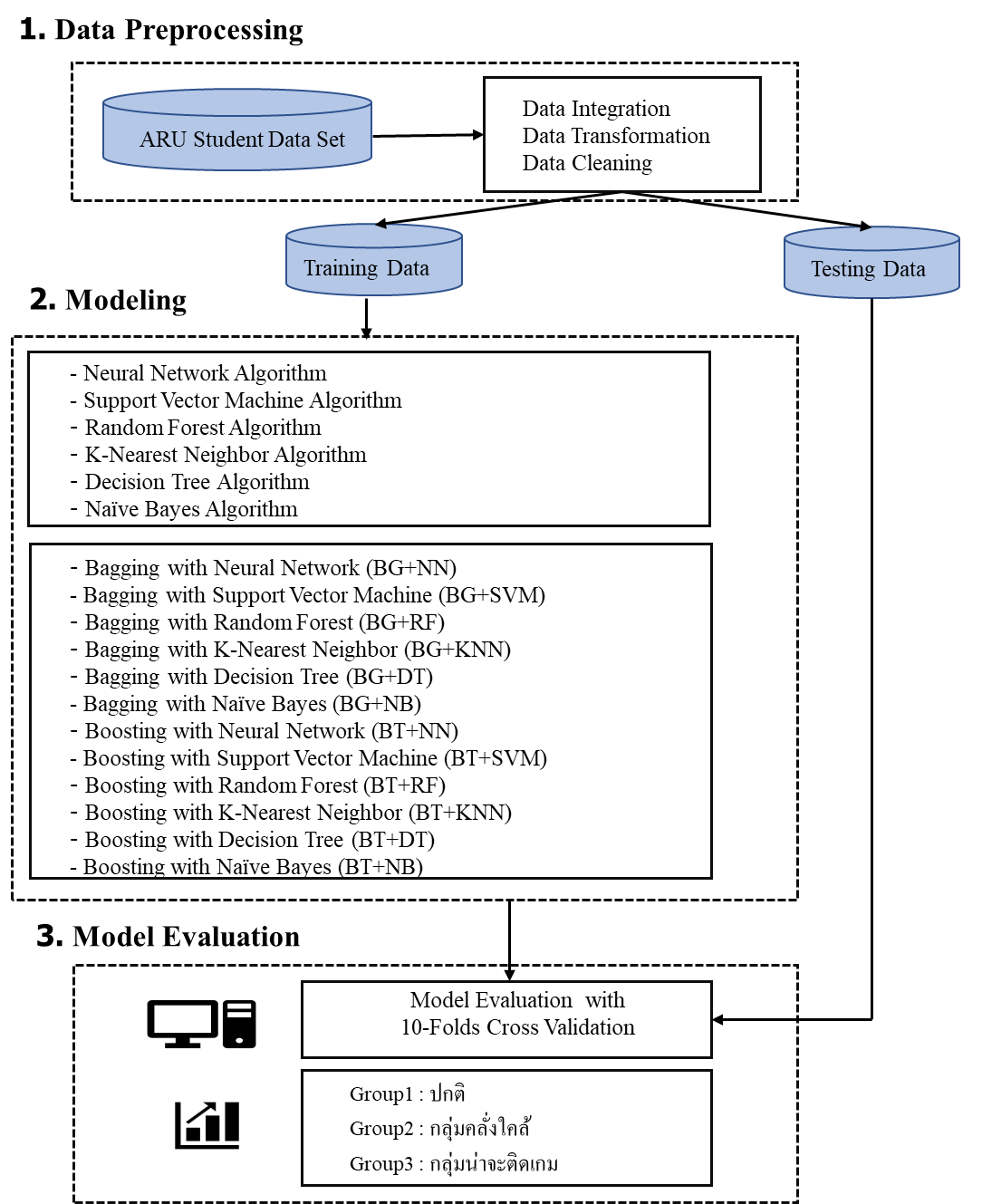Prediction Model of Game Addiction Behavior of Rajabhat University Students with Ensemble Learning Algorithm and Neural Network
Main Article Content
Abstract
This research aimed (1) to study game addiction behavior of Rajabhat University students (2) to create a model and compare the performance of the game addiction behavior prediction model with 6 basic data mining algorithms consisting of neural network, random forest, support vector machine, k-nearest neighbors, decision tree and naïve bayes and (3) to build the model with the ensemble methods 12 algorithm, includes bagging with 6 basic algorithms and boosting with 6 algorithms. The research tools were game addiction screening test (GAST) and RapidMiner Studio 9 program. The sample was students from Phranakhon Si Ayutthaya Rajabhat University. The results revealed that the highest performance model was construction by bagging with neural network model (98.00%), boosting with neural network model (97.60%), respectively. In conclusion, the best model should be applied to develop an application to predict game addiction behavior of Rajabhat University students. In addition, our proposed model is a guideline for finding the cause of game addiction behavior. Surveillance and help people who have problems with game addiction appropriately and develop students' learning to be effective.
Article Details

This work is licensed under a Creative Commons Attribution-NonCommercial-NoDerivatives 4.0 International License.
Articles published in Journal of Industrial Technology Ubon Ratchathani Rajabhat University both hard copy and electronically are belonged to the Journal.
References
World Health Organization, “Inclusion of “gaming disorder.” in ICD-11” World Health Organization. Accessed: Nov. 8, 2021. [Online]. Available: https://www.who.int/news/item/14-09-2018-inclusion
-of-gaming-disorder-in-icd-11
WebMD, “Is video game addiction real?.” Webmd. Accessed: Jun. 20, 2021. [Online]. Available: https://www.webmd.com/mental-health/addiction/video-game-addiction?page=2
Q. Wang, H. Ren, J.Long, Y. Liu and T. Liu, “Research progress and debates on gaming disorder,” General Psychiatry., to be published, doi: 10.1136/gpsych-2019-100071.
R. Singsakda, Online Game Trends, Nonthaburi, Thailand: Department of International Trade Negotiations, 2020. (in Thai)
Department of Mental Health, “Children's problem with game addiction.” dmh. Accessed: Apr. 5, 2021. [Online]. Available: https://www.dmh.go.th/news-dmh/view.asp?id=30036 (in Thai)
C. Pornnophadol, B. Sornpaisan, K. Khamklieng and S. Pattanaamorn, “Development of a game addiction test,” Journal of the Psychiatric Association of Thailand, vol. 59, no. 1, pp. 3-14, 2014.
S. Sinsomboonthong, “An Efficiency comparison in prediction of child and adolescence game addition in bangkok,” Thai Science and Technology Journal, vol. 26, no. 3, pp. 405-16, 2018.
W. Inplang, “Opinion analysis on PUBG mobile game using text mining,” M.Sc. thesis, Dept. Information Technology., Mahasarakham University., Mahasarakham, Thailand, 2020.
S. Sun, J. Yang, Y.-H. Chen, J. Miao and M. Sawan, “EEG signals based internet addiction diagnosis using convolutional neural networks,” Applied Sciences, vol. 12, no. 13, pp. 6297, 2022.
E. Patcharawongsakda, An Introduction to data mining techniques, Bangkok, Thailand: Asia Digital Printing, 2014.
J. Han, M. Kamber and J. Pei, Data mining concepts and techniques, 3rd ed. Waltham, MA, USA: Morgan Kaufmann, 2012.
M. Kantardzic, Data mining: concepts, models, methods, and algorithms, 3rd ed. Hoboken, NJ, USA: John Wiley & Sons, 2019.
P. Tan, M. Steinbach, A. Karpatne and V. Kumar, Introduction to data mining, 2nd ed. Upper Saddle River , NJ, USA: Pearson Education; 2019.
I. H. Witten and E. Frank, Data mining: practical mane learning tools and techniques, 2nd ed. San Francisco, CA, USA: Morgan Kaufmann, 2017.
N. Rojanaburanon, “Rapid miner studio data analysis guide 9.” GotoKnow. Accessed: Mar. 25, 2021. [Online]. Available: https://www.gotoknow.org/posts/660127
E. Patcharawongsakda, Introduction to predictive modeling with rapidMiner studio 9, Bangkok, Thailand: Asia Digital Printing, 2021.
A. Charu C, “Neural Networks and Deep Learning” Springer, 2018.
M. H. Beale, M. Hagan and H.B. Demuth, Neural network toolbox 7 user’s guide, Natick, MA, USA: The MathWorks, Inc. 2010.
B. Elzkorn, “Data normalization and standardization.” Bluehost. Accessed: May. 26, 2021. [Online]. Available: http://www.benetzkorn.com/2011/11/data-normalization-and-standardization
L. Breiman, “Random forests,” Machine Learning, vol. 45, no. 1, pp. 5-32, 2001.
J. Ali, R. Khan, N. Ahmad and I. Maqsood, “Random forests and decision tree,” In JCSI International Journal of Computer Science, vol. 9, no. 5, pp. 272-278, 2012.
M. H. Dunham, Data mining: introductory and advanced topics, Upper Saddle River , NJ, USA: Pearson Education, 2006.
J. R. Quinlan, “Introduction of decision trees,” Machine Learning, vol. 1, no. 1, pp. 9-81, 1986.
S. De, S. Dey, S. Bhattacharyya and S. Bhatia, Data mining advanced data mining tools and methods for social computing, Cambridge, MA, USA: Academic Press, 2022.
S. Sinsomboonthong, Data mining 1, Bangkok, Thailand: King Mongkut's Institute of Technology Ladkrabang, 2017.
S. Euawatthanamongkol. Data mining, 2nd ed. Bangkok, Thailand: Institute of Development Administration, 2019.
T. G. Dietterich, “An Experimental comparison of three methods for constructing ensembles of decision trees: bagging, boosting and randomization,” Machine Learning, vol. 40, pp. 39–157, 2000.
N. Nai-Arun and P. Sittidech, “Ensemble learning model for diabetes classification,” Journal of Advanced Materials Research, vol. 931–932, pp. 1427-1431, 2014.
J. Hongvientiane, N. Lakkanurak and K. HengPhraPhrom, “A Comparison of the efficiency of the classification of autism disease using data mining technique,” in Proc. the 11th NPRU National Academic Conference, Nakhon Pathom, Thailang, Jul. 11-12, 2019, pp. 321-326.


